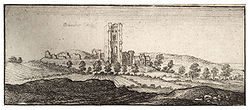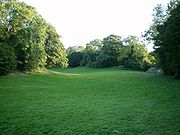
Bramber Castle
Encyclopedia


Normans
The Normans were the people who gave their name to Normandy, a region in northern France. They were descended from Norse Viking conquerors of the territory and the native population of Frankish and Gallo-Roman stock...
motte-and-bailey
Motte-and-bailey
A motte-and-bailey is a form of castle, with a wooden or stone keep situated on a raised earthwork called a motte, accompanied by an enclosed courtyard, or bailey, surrounded by a protective ditch and palisade...
castle in the village of Bramber
Bramber
Bramber is a village and civil parish in the Horsham District of West Sussex, England. It is located on the northern edge of the South Downs and on the west side of the River Adur. Nearby are the communities of Steyning to the west and Upper Beeding to the east, and the other side of the river....
, West Sussex
West Sussex
West Sussex is a county in the south of England, bordering onto East Sussex , Hampshire and Surrey. The county of Sussex has been divided into East and West since the 12th century, and obtained separate county councils in 1888, but it remained a single ceremonial county until 1974 and the coming...
overlooking the River Adur
River Adur
The Adur is a river in Sussex, England; it gives its name to the Adur district of West Sussex. The river was formerly navigable for large vessels up as far as Steyning, where there was a large port, but over time the river valley became silted up and the port moved down to the deeper waters nearer...
.
William De Braose
William de Braose, 1st Lord of Bramber
William de Braose , First Lord of Bramber was previously lord of Briouze, Normandy. He was granted lands in England by William the Conqueror soon after he and his followers had invaded and controlled Saxon England.- Norman victor :De Braose was given extensive lands in Sussex by 1073...
constructed the castle c1070, along with the Norman church, on a natural mound and most of the surviving masonry dates from this time. Except for a period of confiscation during the reign of King John
John of England
John , also known as John Lackland , was King of England from 6 April 1199 until his death...
, Bramber Castle remained in the ownership of the De Braose family until the line died out in 1324.
Despite very little surviving, the basic layout of some areas of Bramber Castle can still be identified. The most prominent feature is a large, rugged lump of stone, all that remains of the Gatehouse tower. Still standing to almost its full height, a single window, and some floor joist holes, are clearly visible within the structure. Beyond the Gatehouse are the existing foundations of what is believed to have been living quarters and a guardhouse. The dressed pillars of an entrance can be made out, but the bulk of the remaining walls now consist of only lumps of basic rough stone infill, the better quality dressing stone having long since been quarried away for use elsewhere. Lying to the north of the gatehouse is the original castle motte, its earthen mound rising to a height of some 30 ft (10 m). A short distance away is a section of the curtain wall and, again, this survives to a reasonable height, up to 10 ft (3 m) in places.
Little is known of Bramber Castle's history and even records kept during the Civil War
English Civil War
The English Civil War was a series of armed conflicts and political machinations between Parliamentarians and Royalists...
only mention a 'skirmish' in the village c1642. The church suffered quite badly as a result of the Parliamentarian guns being set up in the transepts, where they afforded a better vantage point to fire on Bramber Castle.
Although there is not much to see among the fragmentary ruins, the lawned areas in the bailey are well maintained, mature trees have transformed the motte into a shady glade, and the moat now provides a path around the castle perimeter from which to view the site.
There is also a small church (still in use today ) located directly next to the castle's entrance, which used to be a chapel for the castle's inhabitants.
In the Domesday Book
Domesday Book
Domesday Book , now held at The National Archives, Kew, Richmond upon Thames in South West London, is the record of the great survey of much of England and parts of Wales completed in 1086...
survey of the country in William I of England
William I of England
William I , also known as William the Conqueror , was the first Norman King of England from Christmas 1066 until his death. He was also Duke of Normandy from 3 July 1035 until his death, under the name William II...
's reign, it was ascertained that Bramber belonged to William de Braose, who possessed also forty other manors.
The family were left in possession of their estates by the service of ten knights' fees
Knight's fee
In feudal Anglo-Norman England and Ireland, a knight's fee was a measure of a unit of land deemed sufficient from which a knight could derive not only sustenance for himself and his esquires, but also the means to furnish himself and his equipage with horses and armour to fight for his overlord in...
to the Crown, but in John I's tyrannical reign the troubles of the owners of Bramber Castle began. In the year 1203 the anger of the barons began to find voice, and John I, alarmed at the symptoms of disaffection, required hostages of them.

Arthur I, Duke of Brittany
Arthur I was Duke of Brittany between 1194 and 1202. He was the posthumous son of Geoffrey II, Duke of Brittany and Constance, Duchess of Brittany...
, his kinsman." The imprudent words were made known to John I, who never forgave them. He ordered the family to be seized; but his men arrived too late to execute his orders - the De Braoses had fled to Ireland.
They had, however, only escaped for a time. The king caused them to be followed, and at length succeeded in having them seized, and sent to him. They were taken to Windsor Castle
Windsor Castle
Windsor Castle is a medieval castle and royal residence in Windsor in the English county of Berkshire, notable for its long association with the British royal family and its architecture. The original castle was built after the Norman invasion by William the Conqueror. Since the time of Henry I it...
, where the family were shut up together in a room - the whole family (save one)-and were there starved to death by John's order. One son, William de Breose, who was married and had a son, escaped and fled to France but died shortly afterwards.
John I had previously taken possession of his estates and given them to his son Richard; but he restored Bramber to William's son Reginald, the last of his family.
John, the heir apparent of Reginald, died by a fall from his horse in Henry III's
Henry III of England
Henry III was the son and successor of John as King of England, reigning for 56 years from 1216 until his death. His contemporaries knew him as Henry of Winchester. He was the first child king in England since the reign of Æthelred the Unready...
reign, and that sovereign's brother took charge of the castle until the infant heir was of age.
Bramber devolved at length to the Mowbrays, but was forfeited to the Crown when John de Mowbray was executed for treason, having joined the nobles against the Spencers, the favourites of Edward II
Edward II of England
Edward II , called Edward of Caernarfon, was King of England from 1307 until he was deposed by his wife Isabella in January 1327. He was the sixth Plantagenet king, in a line that began with the reign of Henry II...
.
It was restored by Edward III
Edward III of England
Edward III was King of England from 1327 until his death and is noted for his military success. Restoring royal authority after the disastrous reign of his father, Edward II, Edward III went on to transform the Kingdom of England into one of the most formidable military powers in Europe...
to his son, who had followed his liege to the French wars.
Further reading
- Fry, Plantagenet Somerset, The David & Charles Book of Castles, David & Charles, 1980. ISBN 0-7153-7976-3

